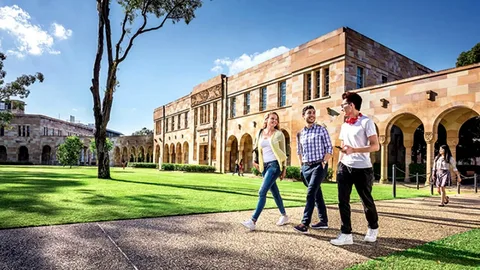Jobs and education
Why Ethical and Responsible AI Should be Non-Negotiable for Businesses Around the World

Introduction
As artificial intelligence (AI) continues to evolve and become more mainstream, it’s becoming increasingly important for businesses around the world to prioritize ethical and responsible AI practices. While there are certainly many benefits associated with AI technology, such as increased efficiency and improved decision-making capabilities, there are also numerous potential risks that must be considered. That’s why in this blog post we’ll dive into the importance of ethical and responsible AI, exploring both its argument and reality while discussing what implications these have for businesses today. So buckle up as we take a deep dive into this vitally important topic!
The Argument for Ethical and Responsible AI
As businesses around the world continue to invest in artificial intelligence (AI), it is crucial that they prioritize ethical and responsible AI practices. There are several compelling arguments for doing so.
Firstly, ethically sound AI ensures that decisions made by machines align with human values and morals. This means that AI systems will not make decisions that discriminate against certain groups or violate basic human rights.
Secondly, responsible AI can help avoid negative consequences such as bias or errors in decision-making which could lead to harm – both physical and emotional – for individuals affected by those decisions.
Furthermore, ethical and responsible AI helps build public trust in companies using these technologies. Consumers are becoming increasingly aware of how their data is being used and demand transparency when it comes to the use of advanced machine learning algorithms.
Ultimately, promoting ethics in AI should be seen as an investment rather than a cost. By taking responsibility for developing ethical and transparent approaches to implementing AI technologies, businesses stand to gain significant long-term benefits while ensuring accountability for all stakeholders involved.
The Reality of Ethical and Responsible AI
The reality of ethical and responsible AI is not always as straightforward as businesses may hope. While there are certainly benefits to implementing these principles, it’s important to recognize the challenges that come along with them.
For one, developing ethical and responsible AI requires a significant investment of time, money, and resources. Businesses must be willing to devote the necessary funds and personnel to ensure that their AI systems are designed with fairness, transparency, accountability, and privacy in mind.
Furthermore, even with the best intentions and efforts towards creating ethical AI systems, unintended consequences can still arise. Bias can creep into algorithms if not properly accounted for during development or testing phases. This could lead to unfair treatment towards certain groups or individuals.
Moreover, stakeholder engagement is crucial throughout the entire process of developing ethical AI systems. This includes engaging with diverse voices from different fields such as academia ethics experts; civil society organizations; labour unions; consumer advocacy groups etc., who bring diverse perspectives on what constitutes “ethical” technology design.
Though it is worth noting that while there may be challenges associated with pursuing ethically sound artificial intelligence solutions – including costs/time investments involved in ensuring fairness/transparency/accountability/privacy considerations – this shouldn’t dissuade businesses from pursuing these goals given increasing concerns around societal impact/effects from biased/unfair data-driven decision making models being deployed today without adequate checks/balances/review mechanisms in place at present time!
Implications for Businesses
Businesses that adopt ethical and responsible AI practices are likely to see a positive impact on their reputation, customer loyalty, and financial performance. In contrast, those that fail to do so risk damaging their brand image and losing customers.
Firstly, businesses that prioritize ethical and responsible AI can build trust with their customers by ensuring the protection of personal data privacy. This helps in building brand loyalty as people become more concerned about how companies use their data.
Secondly, implementing ethical AI also means being transparent about decision-making processes. It ensures that algorithms aren’t biased against certain groups or individuals based on factors like race or gender. The result is fairer outcomes for all stakeholders which can have a positive impact on the company’s overall reputation.
Thirdly, adopting responsible AI practices could lead to increased efficiency through automation of manual processes while minimizing errors caused by human error, resulting in cost savings over time.
It is essential for businesses to stay up-to-date with evolving regulations around artificial intelligence technology globally. Non-compliance could lead to serious legal implications such as fines or even lawsuits from affected parties due to unethical use of AI.
Incorporating ethical and responsible AI should be an integral part of every business’ strategy because it not only positively impacts its bottom line but also creates a safer environment for everyone involved with the company’s operations.
Conclusion
Ethical and responsible AI is not just a moral obligation that businesses should fulfill, but also a strategic move for long-term success. As artificial intelligence continues to advance and become more integrated into our daily lives, it’s crucial that we prioritize the development of fair and transparent systems. This can only happen when businesses recognize the importance of ethical AI practices.
By adopting ethical and responsible AI practices, businesses can create trust with their customers, mitigate risks associated with potential biases or discrimination in automated decision-making processes, and ultimately build a stronger brand reputation. It’s time for all companies around the world to make non-negotiable commitments towards developing ethical and responsible AI solutions that benefit everyone while ensuring that no one is left behind.
Development
A Comprehensive Guide to Studying in Australia with IVY Overseas
Development
IVY Overseas: Premier Education Consultants in Hyderabad
Beauty Fitness
Ultimate Guide to Buying Quality Beet Juice for Optimal Health

Are you wondering where to buy beet juice that’s both high-quality and effective? You’re not alone. As more people discover the incredible health advantages of this ruby-red superfood, the demand for premium beetroot products continues to surge.
However, navigating the crowded marketplace can feel overwhelming. This detailed guide will walk you through everything you need to know about purchasing the best beet juice for your wellness journey.

Understanding the Beet Juice Phenomenon
Before exploring purchase options, it’s essential to grasp why beet juice has become a staple in health-conscious households worldwide. This nutrient-dense beverage contains an impressive array of vitamins, minerals, and potent antioxidants that support overall wellness. The real game-changer, however, is its exceptional concentration of dietary nitrates.
Your body transforms these nitrates into nitric oxide, a molecule that influences numerous physiological processes. From enhancing blood circulation to optimizing oxygen transport throughout your system, nitric oxide serves critical functions. Many individuals exploring natural wellness solutions have discovered the important relationship between nitric oxide and erection health, as enhanced circulation provides benefits that extend far beyond exercise performance.
Your Best Options for Purchasing Beet Juice
1. Dedicated Online Health Retailers (Top Choice)
Purchasing from specialized online platforms represents the most practical approach to securing premium beetroot juice. These digital marketplaces focus exclusively on wellness products and typically provide:
- Reliable standards: Established online retailers enforce rigorous quality protocols
- Extensive selection: Various formats from concentrate shots to full-size bottles
- Comprehensive details: Full nutritional profiles and usage guidelines
- Authentic feedback: Genuine testimonials from verified purchasers
- Hassle-free shipping: Products arrive at your home
- Competitive costs: Generally more affordable than brick-and-mortar locations
When browsing online, seek out companies that openly share information about their ingredient sourcing, production techniques, and nitrate concentrations. Top-tier brands frequently use organically-grown beets and utilize cold-extraction methods to maintain nutritional integrity.
2. Natural Food Retailers
Specialty health stores and organic markets commonly carry beetroot juice options. Benefits include:
- Physical product inspection before purchase
- Same-day availability
- Contributing to community businesses
- Access to informed employees who can provide guidance
The downside is that inventory might be restricted, and costs often exceed online alternatives.
3. Conventional Supermarkets
Mainstream grocery stores increasingly feature beet juice in their wellness or beverage aisles. While accessible, these options may:
- Include unnecessary sweeteners or additives
- Be watered down with filler juices
- Offer reduced nitrate levels
- Lack the specialization of dedicated brands
4. Fresh Market Vendors and Juice Establishments
Local farmers markets and pressed juice cafes offer freshly-made alternatives. Consider that:
- Quality fluctuates considerably
- Uniformity cannot be guaranteed
- Products expire more quickly
- Premium pricing is standard
Essential Factors When Selecting Beet Juice
Quality Markers
Certified Organic: Guarantees beets are cultivated without chemical pesticides or artificial fertilizers, particularly important since root vegetables can concentrate soil impurities.
Nitrate Concentration: Premium beet juice products should transparently display nitrate levels. Target products offering a minimum of 400mg nitrates per portion for meaningful results.
Component Listing: Simplicity is key. Authentic beet juice should contain very few ingredients—ideally just organic beets and possibly lemon juice for freshness.
Extraction Technique: Cold-extraction or fresh-pressed approaches retain superior nutrients versus heat-based processing.
Zero Added Sweeteners: Natural beet sweetness is sufficient, and supplemental sugars diminish health advantages.
Available Formats
Concentrated Portions: Perfect for athletes and individuals wanting maximum nitrate delivery in compact servings. Typically 70-100ml doses.
Standard Bottles: Practical for everyday use, usually available in 250-500ml sizes.
Dehydrated Powder: Extended storage capability and travel-friendly, though absorption may be marginally lower than liquid forms.
Combination Beverages: Merged with additional vegetables or fruits, which can enhance flavor but potentially reduce beet concentration.
The Research Supporting Beet Juice Advantages
Recognizing the benefits clarifies why quality selection matters. Beet juice ranks among the most concentrated dietary sources in foods high in nitric oxide precursors. When consuming dietary nitrates from beets, your system converts them through a biological pathway involving oral bacteria and gastric processes.
Primary Health Advantages
Heart Health Enhancement: Nitric oxide assists in relaxing and widening blood vessels, supporting optimal blood pressure and circulation patterns.
Exercise Optimization: Research demonstrates beet juice can boost stamina, decrease oxygen requirements during activity, and elevate athletic output.
Brain Function Support: Enhanced blood delivery to the brain potentially supports mental sharpness and cognitive capabilities.
Sustained Vitality: Unlike stimulant-based energy drinks, beet juice delivers lasting energy through optimized oxygen distribution.
Cleansing Properties: Betalain compounds in beets assist liver operations and natural purification mechanisms.
Recommended Beet Juice Quantities
Appropriate amounts vary based on objectives:
- Everyday wellness: 250ml (roughly 8 oz) per day
- Athletic enhancement: 500ml, consumed 2-3 hours pre-workout
- Cardiovascular maintenance: 250-500ml daily with consistency
Begin with modest quantities if you’re new to beet consumption, as some individuals experience digestive adaptation or temporary color changes in bodily waste (completely normal and harmless).
Optimal Timing for Beet Juice Consumption
Athletic Goals: 2-3 hours prior to training permits ideal nitrate transformation and uptake.
General Wellness: Morning intake on an empty stomach or between meals enhances absorption efficiency.
Blood Pressure Management: Consistent daily scheduling helps sustain steady benefits.
Investment Considerations
While cost shouldn’t dictate your decision entirely, understanding value is important:
- High-grade concentrated shots: $3-5 each serving
- Standard bottles: $2-4 per serving
- Volume purchases: Frequently 20-30% reduced pricing
- Recurring delivery: Extra 10-15% price reductions
Premium beet juice constitutes a wellness investment. When evaluating prices, assess the nitrate content per dollar rather than simply volume measurements.
Preservation and Longevity
Sealed Products: Most commercial varieties remain fresh for 12-18 months when kept in cool, dark environments.
After Opening: Refrigerate and finish within 7-10 days for peak freshness and nutrient preservation.
Freshly Pressed: Consume within 2-3 days for optimal quality.
Finalizing Your Purchase Strategy
When determining where to buy beet juice, evaluate:
- Accessibility: How vital is home delivery compared to instant availability?
- Quality standards: Do you need organic validation or particular nitrate thresholds?
- Financial parameters: What’s your comfortable price range for ongoing use?
- Purpose: Are you using it for athletic training, everyday health, or targeted wellness objectives?
- Flavor preferences: Do you want pure beet or mixed varieties?
Warning Signs to Watch For
Overloaded Formulas: Extended ingredient panels featuring preservatives, synthetic flavoring, or sweetening agents.
Unclear Origins: Missing details about beet cultivation location or juice production methods.
Hidden Nitrate Data: Reputable companies should openly communicate nitrate measurements.
Exaggerated Marketing: Watch for inflated health declarations lacking scientific support.
Suspiciously Cheap Pricing: When costs seem unrealistically low, quality is often sacrificed.
Final Recommendation: Your Best Purchasing Approach
For the majority of consumers, buying from a specialized digital retailer delivers the optimal balance of quality, convenience, and affordability. You’ll discover products engineered specifically for maximum wellness impact, featuring transparent details about ingredient origins and nutritional composition.
Prioritize companies that:
- Source organic, non-GMO beets
- Display clear nitrate concentration data
- Use cold-extraction or gentle processing techniques
- Supply customer assistance and educational materials
- Maintain favorable customer testimonials and ratings
- Present flexible buying arrangements including auto-delivery
Final Thoughts
Discovering where to buy beet juice becomes straightforward when you emphasize quality, recognize key purchasing criteria, and select trustworthy suppliers.
You can confidently add this remarkable superfood to your wellness routine. Whether you’re an athlete pursuing performance improvements, someone focused on heart health, or simply aiming to enhance overall vitality, quality beet juice offers valuable nutritional support.
Keep in mind that regularity trumps perfection. Begin with a credible source, observe your body’s response, and modify your consumption accordingly. The advantages of beet juice manifest most effectively through consistent, ongoing use of superior products.
Prepared to embrace the benefits of exceptional beet juice? Choose intelligently, and your body will reward you with improved health and vitality.
-
Business2 years ago
Cybersecurity Consulting Company SequelNet Provides Critical IT Support Services to Medical Billing Firm, Medical Optimum
-
Business3 years ago
Team Communication Software Transforms Operations at Finance Innovate
-
Business3 years ago
Project Management Tool Transforms Long Island Business
-
Business2 years ago
How Alleviate Poverty Utilized IPPBX’s All-in-One Solution to Transform Lives in New York City
-
health3 years ago
Breast Cancer: The Imperative Role of Mammograms in Screening and Early Detection
-
Sports3 years ago
Unstoppable Collaboration: D.C.’s Citi Open and Silicon Valley Classic Unite to Propel Women’s Tennis to New Heights
-
Art /Entertainment3 years ago
Embracing Renewal: Sizdabedar Celebrations Unite Iranians in New York’s Eisenhower Park
-
Finance3 years ago
The Benefits of Starting a Side Hustle for Financial Freedom


































